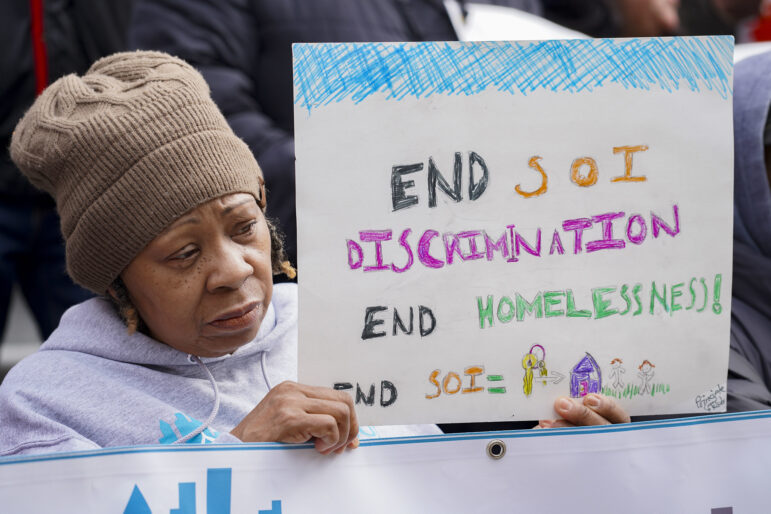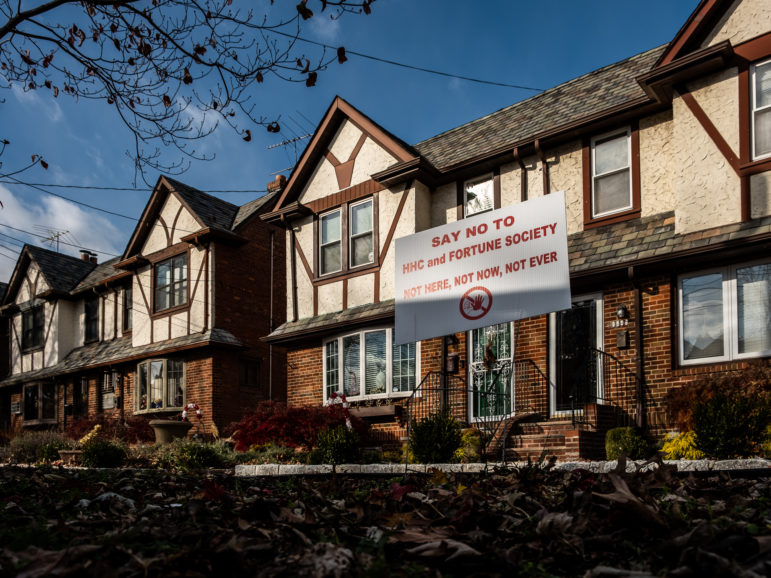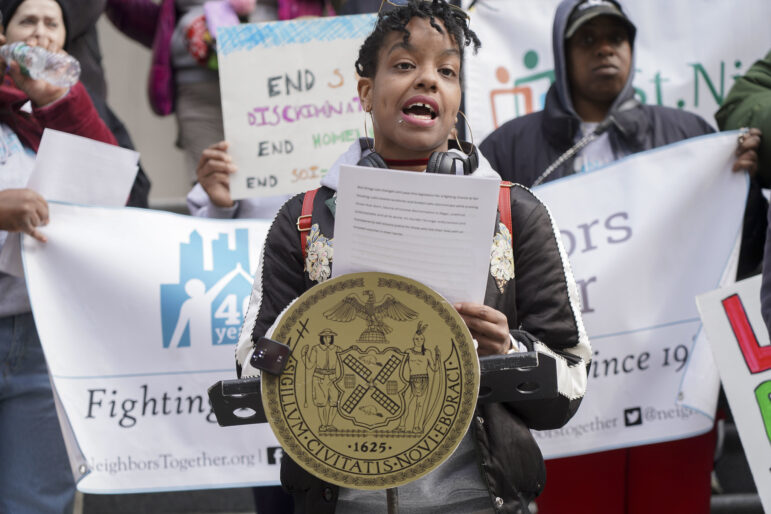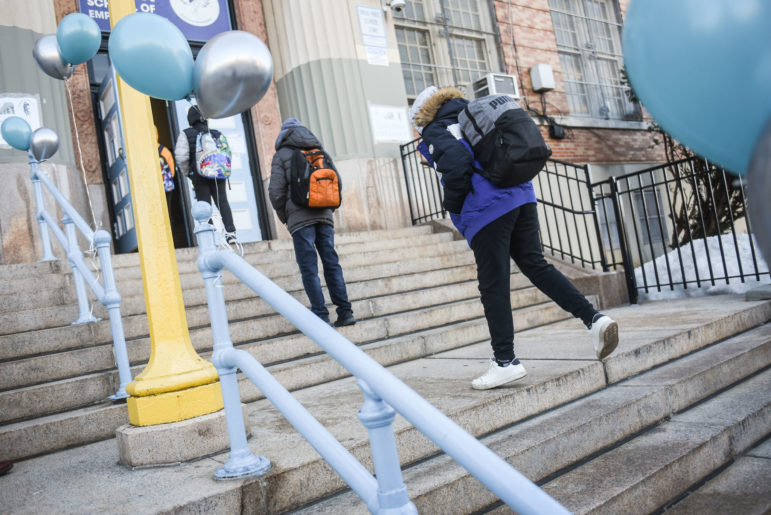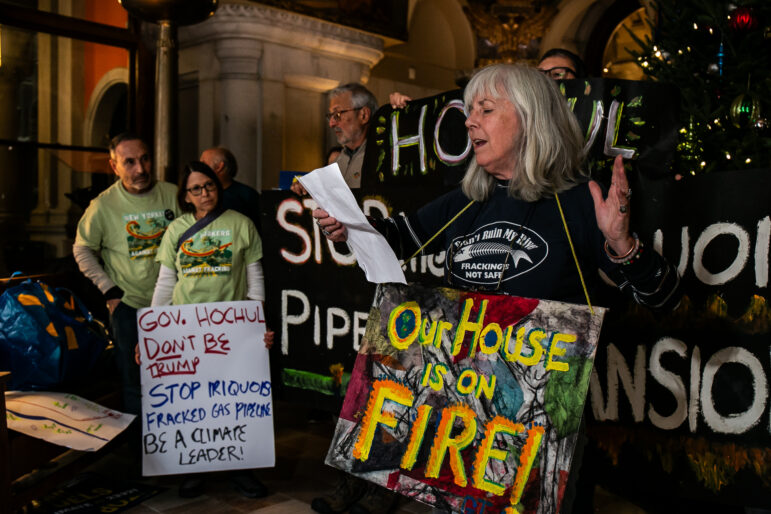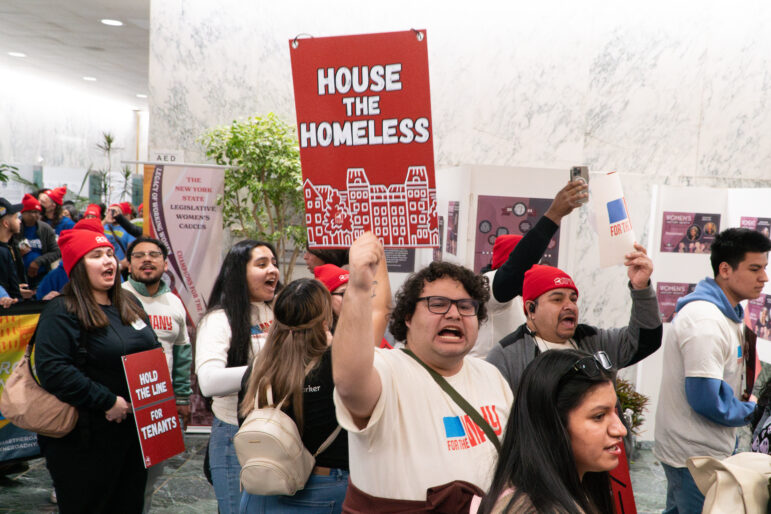Despite being under court order to remediate it, mold remains a persistent problem for NYCHA, which points to its aging infrastructure and a climbing number of physical needs across its portfolio, particularly as it pertains to plumbing.
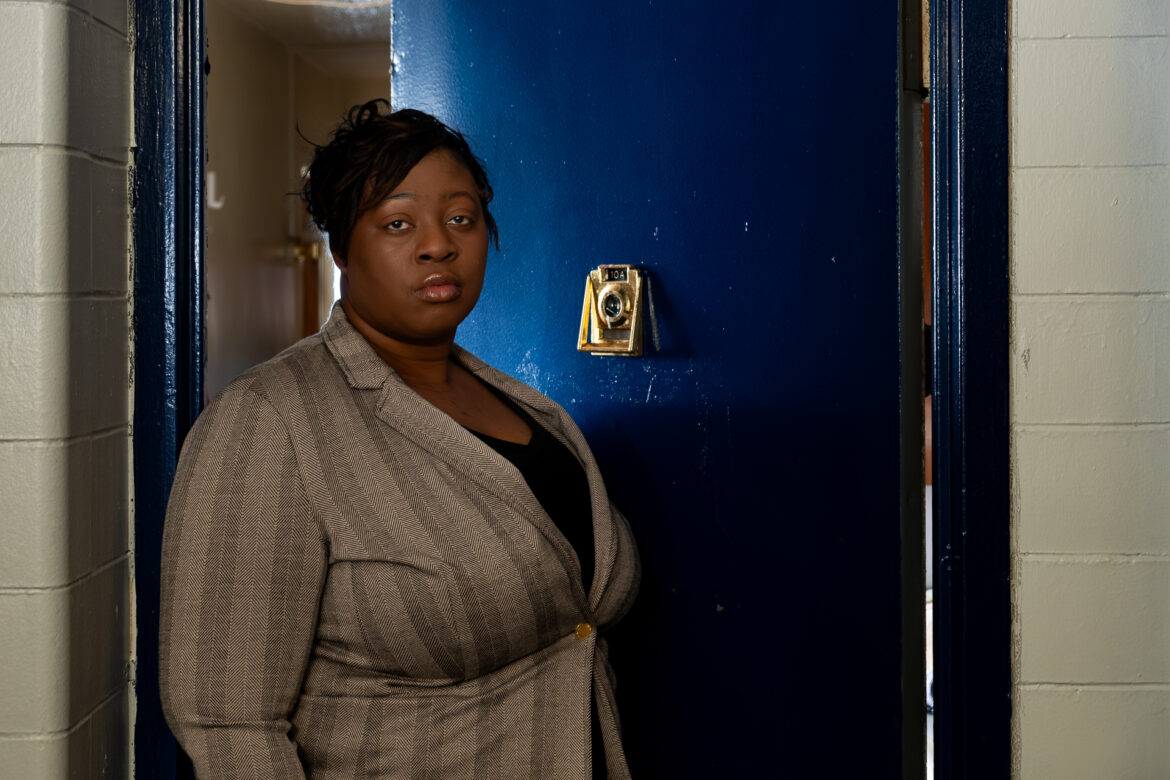
Adi Talwar
Kadisha Davis, a resident of NYCHA’s Ingersoll Houses, says she’s had mold in her bathroom for roughly a year.After submitting a work order, it took just a couple of days for Kadisha Davis, a resident at the Ingersoll Houses in Brooklyn, to get a response from NYCHA.
The issue was in her bathroom. Patches of mold that Davis compared to pre-punched loose leaf holes were clustered on the corners of her walls. Part of her ceiling had formed bubbles, which she expected to burst at any moment. Over the toilet was an inconsistent but steady leak, oozing trickles of water.
“It’s more like a drip, drip, drip, drip,” the Brooklyn tenant remembers describing to the inspector during an initial visit. She wondered if the leak could be the reason for the mold, and if the mold would harm her and her 9-year-old child.
After that first assessment, the inspector went to the unit upstairs to see if the origin of a leak could be detected there, but Davis said nothing was determined. The inspector took pictures, she said, and within three weeks Davis received a letter recommending her windows be left open for ventilation.
It’s been one year since the work order was placed. In that time, Davis guesses there were up to 10 additional inspections. The mold remains.
“It’s hard to keep up, to be honest,” said Davis.
Despite being under court order to remediate mold, it remains a persistent problem for NYCHA. In April, The City reported that close to 77,000 of NYCHA’s open work order submissions were related to mold and leaks, and the time frame to resolve these matters is not always speedy.
NYCHA residents: what is your experience with the mold remediation process? Reach out to tatyana@citylimits.org.
In its latest report published in December, Jenner and Block, the law firm that serves as a federal monitor for NYCHA, found that the housing authority remediated or removed mold in the required five-day time period only 9 percent of the time between February and October 2024. U.S. Department of Housing and Urban Development (HUD) rules require mold to be removed on time 95 percent of the time.
Between July and October, the first four months of the current fiscal year, the housing authority removed mold within the required five-day period just 7.7 percent of the time, according to the most recent Mayor’s Management Report.
It attributed the dip to “changes to the increased workload for maintenance workers and development staff in other critical areas, such as the HUD requirement implemented in Calendar 2024 that NYCHA inspect every apartment each year, and the work to increase the number of vacant apartment turnovers at each property.”
NYCHA, while acknowledging the magnitude of its mold issues, points to additional challenges that the housing authority faces such as aging infrastructure and decades of funding disinvestment, which has fueled a climbing number of physical needs across its portfolio, particularly as it pertains to plumbing.
Addressing mold, according to NYCHA, is not a one-size-fits-all approach. There may be multiple factors, including the involvement of specialty staff and coordination with residents to access their apartments.
After a tenant submits a ticket regarding a mold concern, they can expect to hear back from an inspector who will attempt to find the root cause, such as the source of any leaks, according to NYCHA. The inspector might take photos and follow up with an “information receipt” regarding next steps.
The timeline of mold remediation depends on whether the condition is labeled as “simple”—which the housing authority said it aims to complete within seven days—or “complex,” which is when the removal process could include various workers to get the job done, including painters and plumbers, within an aim of 15 days. After remediation is complete, NYCHA makes a final assessment to measure the effectiveness of the repair work.
A majority of the significant delays can be attributed to painting after the mold removal, according to NYCHA, which cited access to tenants’ apartments as a challenge. The remediation process could include multiple visits with different specialty staff—each requiring coordination between residents and their own schedules.
It’s a step that Davis is uncomfortable with. Since the source of the dripping water still hasn’t been found, Davis has not yet allowed the painters in.
“I never allowed them in my apartment to do that because I don’t think it makes sense to do one thing and then other problems are still existing,” said Davis. “I need you to stop the leaking and what’s causing the mold.”
Davis, who moved to the housing development in Fort Greene seven years ago, told City Limits that one of her concerns with having NYCHA do the paint job is not knowing if the mold will return underneath the fresh coat.
“I may not see the mold anymore, but God forbid I can’t see it because [paint] is blocking it out,” said Davis. “People can get lung problems and that’s what I don’t want to happen with me and my daughter. My allergies have gotten worse since I’ve been here.”
Molds can irritate sinuses, airways and lungs which can cause coughing, wheezing and shortness of breath, according to Dr. Joshua Nosanchuk, a professor of medicine, microbiology and immunology, and an infectious disease physician at Montefiore Health System (Nosanchuk spoke to City Limits about the potential impact of mold exposure generally, not in relation to Davis’ situation or NYCHA’s policies).
The direct impact mold has can vary from person to person and their circumstances, especially since some level of mold can be found in every household. “This depends on whether the person is sensitive to the mold(s) or not,” Nosanchuk told City Limits over email. “It also depends on the quantity of mold in the space—more mold, likely more reactions.”
NYCHA’s monitor discovered that in 84 percent of mold complaints between February and October 2024, the fungus spanned 10 or more feet. HUD requirements state that no more than 15 percent of mold in apartments can be that large.
The long-term effects of mold on health are not exactly clear, according to Nosanchuk. “It, however, seems that ongoing exposure may be associated with chronic bronchitis, asthma or other chronic obstructive pulmonary diseases (like COPD),” he said. Other allergic reactions can also come about, he added.
“There is the ‘sick building syndrome’ where ‘toxic black molds’ (e.g. stachybotrys) have been associated with changes in cognition (especially memory problems) as well as chronic headaches and generalized fatigue,” Nosanchuk said.
Sick building syndrome, for example, was prevalent after Hurricane Katrina landed in New Orleans in 2005, where homes had “massive mold and mildew blooms,” according to Nosanchuk. In addition to abatement, he recommends tenants use high efficiency particulate air or HEPA filters in areas with increased mold risks.
Cameron Clarke, campaign coordinator with WE ACT for Environmental Justice, said that mold is just one of the health-impacting housing conditions many public housing residents deal with. These factors are “sort of cumulative in nature.”
“[If you’re somebody who is in an apartment in NYCHA housing where you’ve just had issues with mold abatement, it’s possible that you’re also dealing with issues with pest management whether that’s rats or roaches or mildew or dust or sort of indoor air pollutants in your indoor environments,” said Clarke. Other contributors which can worsen the air quality in a unit include smoke, candles and gas stoves.
“If you’re walking around in the street and you’re being exposed to exhaust from vehicles and from the subway and from the fumes that are being emitted at street level, those are some air pollutants you might recognize as dangerous,” said Clarke. “But we actually routinely see levels of air pollution that are orders of magnitude higher in some of these housing units.”
On NYCHA’s end, it says strides are being made to improve mold conditions, citing the creation of an Office of Mold Assessment and Remediation in 2018, which is dedicated to monitoring response times as well as compliance.
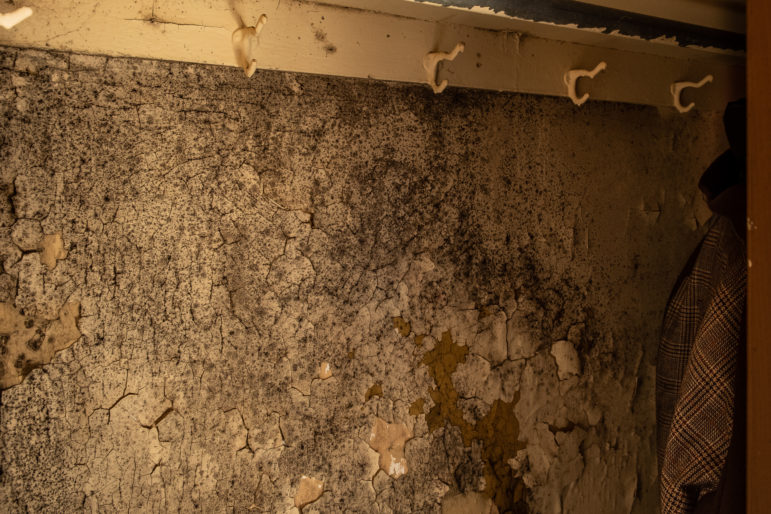
Adi Talwar
A closet with water damage and mold in an apartment at NYCHA’s Red Hook West Houses in 2022.It also launched the Mold and Leak Performance Scoreboard in the spring of 2022. The tool, which is updated twice a week, rates the housing authority’s performance using 11 metrics, like the median number of days for both complete and incomplete mold inspections. The oversight stems from a December 2013 lawsuit, Baez v. NYCHA, which claimed that the housing authority did not efficiently remediate mold or moisture for tenants with asthma even with requirements on the state and federal level.
Keeping the housing authority accountable is also the Ombudsperson Call Center (OCC), which was established under a court order in 2020 after mold issues were not being addressed in a timely manner.
In the near three-year period since the introduction of the scorecard, there have been improvements: an 84 percent reduction in the median number of days for NYCHA to inspect mold, a 14 percent increase in work orders scheduled with a set date, a 31 percent improvement in high priority OCC cases resolved within 30 days and an 11-point increase in resident satisfaction.
“NYCHA is dedicated to performing the work necessary to provide residents with a mold-free home,” a NYCHA spokesperson said. “NYCHA regularly works with the court-appointed Ombudsperson Call Center, and together have assisted over 16,000 residents with mold-related concerns to date, having resolved 3,400 cases in just the last year.”
For Davis, the latest inspector informed her that remediation will take place but she may need to relocate during the process. She is still waiting to hear back from her case worker to hear about next steps.
“That’s the last thing he said to me,” said Davis, who said is willing to temporarily move as long as the mold is resolved. “I’m gonna take his word for it.”
To report mold residents can report the issue to NYCHA through the Customer Contact Center (CCC) at 718-707-7771 or by creating a Mold Inspection work order via the MyNYCHA app.
Tenants who already tried contacting the CCC but still have existing concerns can contact the NYCHA Compliance Department online at on.nyc.gov/submit-concern, or by calling the CCC t (718) 707-7771 (Option #7 for Compliance).*
To reach the reporter behind this story, contact Tatyana@citylimits.org. To reach the editor, contact Jeanmarie@citylimits.org
Want to republish this story? Find City Limits’ reprint policy here.
*This story has been updated to include new contact info from NYCHA for its Compliance Department.


